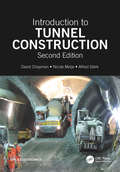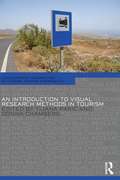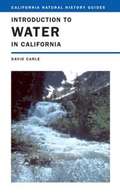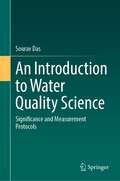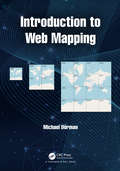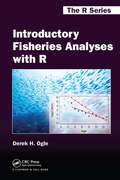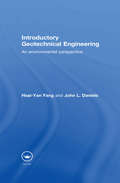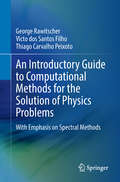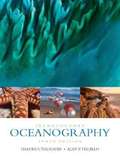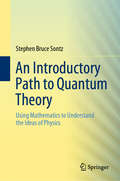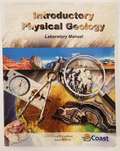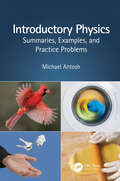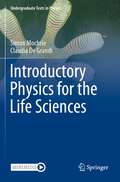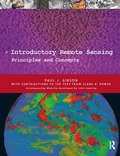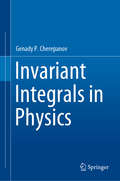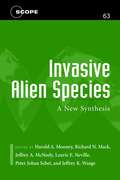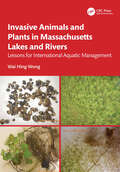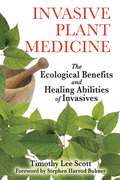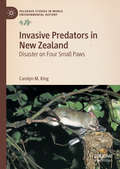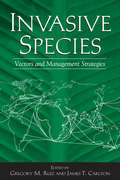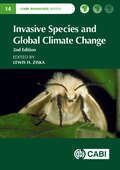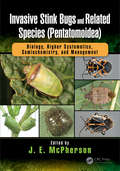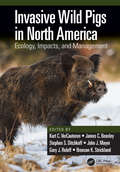- Table View
- List View
Introduction to Tunnel Construction (Applied Geotechnics Ser.)
by David N. Chapman Nicole Metje Alfred StarkTunnelling provides a robust solution to a variety of engineering challenges. It is a complex process, which requires a firm understanding of the ground conditions as well as the importance of ground-structure interaction. This book covers the full range of areas related to tunnel construction required to embark upon a career in tunnelling. It also includes a number of case studies related to real tunnel projects, to demonstrate how the theory applies in practice. New features of this second edition include: the introduction of a case study related to Crossrail’s project in London, focussing on the Whitechapel and Liverpool Street station tunnels and including considerations of building tunnels in a congested urban area; and further information on recent developments in tunnel boring machines, including further examples of all the different types of machine as well as multi-mode machines. The coverage includes: Both hard-rock and soft-ground conditions Site investigation, parameter selection, and design considerations Methods of improving the stability of the ground and lining techniques Descriptions of the various main tunnelling techniques Health and safety considerations Monitoring of tunnels during construction Description of the latest tunnel boring machines Case studies with real examples, including Crossrail’s project in London Clear, concise, and heavily illustrated, this is a vital text for final-year undergraduate and MSc students and an invaluable starting point for young professionals and novices in tunnelling.
An Introduction to Visual Research Methods in Tourism (Contemporary Geographies of Leisure, Tourism and Mobility)
by Donna Chambers Tijana RakićAn Introduction to Visual Research Methods in Tourism is the first book to present, discuss and promote the use of a range of visual methods in tourism studies. It introduces methods ranging from the collection of secondary visual materials for the purposes of analysis (such as postcards, tourism brochures, and websites) and the creation of visuals in the context of primary research (such as photography, video and drawings), to the production of data through photo-elicitation techniques. The book promotes thoroughly underpinned interdisciplinary visual tourism research and includes an exploration of many key philosophical, methodological and inter-disciplinary approaches. Comprised of five parts: introduction; paradigms, academic disciplines and theory; methods; analysis and representation; and conclusion. This volume informs and inspires its readers through a reliance on theory, examples from tourism studies conducted in various geographical locations and through key pedagogical features such as annotated further readings, practical tips boxes and concise chapter summaries. This book will be of interest to experienced visual tourism researchers, scholars wishing to incorporate visual methods in their studies of tourism for the very first time, as well as students on undergraduate, postgraduate or doctoral programmes who are contemplating the incorporation of visual methods in their studies of tourism.
Introduction to Water in California
by David CarleThis book is a natural history guide, but one that recognizes the overwhelming role of humanity in the story of California water. The focus here is on a contemporary understanding of the natural waterscape and watersheds of the state and of the extended watersheds that people created by redirecting water across the West. The goal is to help Californians better appreciate the water that emerges from their taps, what it takes to move it there, and what changes occur in environments along the way.
An Introduction to Water Quality Science: Significance and Measurement Protocols
by Sourav DasThis book discusses the significance of water quality parameters in aquatic ecosystems, offering a concise and practical measurement methodology for early career researchers and post-graduate students in the fields of environmental science, oceanography, and aquatic science . The keys topics covered include aquatic sampling, basics of physicochemical properties and carbonate chemistry of aquatic science , the importance of nutrients in natural water bodies, biological productivity in aquatic ecosystems, aquatic pollution, and statistical analyses of different types of water science data. Several parameters such as microplastics, dimethylsulfoniopropionate and polychlorinated biphenyls have also been incorporated in the book for comprehensive coverage of the topic. The book is meant as a practical guide for beginners and young researchers using a clear writing style and practical examples, highlighting the significance of water science parameters and their measurement protocols in aquatic environments.
Introduction to Water Resources and Environmental Issues
by Thomas V. Cech Karrie Lynn PenningtonHow much water does the world need to support growing human populations? What factors influence water quality, droughts, floods, and waterborne diseases? What are the potential effects of climate change on the world's water resources? These questions and more are discussed in this thorough introduction to the complex world of water resources. The strength of the book is its coverage of the fundamentals of the science of water, aquatic ecology, geomorphology and hydrology, supplemented by internet resources and examples from water resource issues in the news to engage the student. The book begins with a short history of human use and influence on water, followed by chapters on the geomorphology, hydrology, chemistry, and biology of lakes, rivers, and wetlands. Major disease issues, worldwide water quality and quantity problems, and potential solutions are addressed. Water laws, water allocation, and the conflicts involved are discussed using US and international examples. Students in departments of environmental studies, life science, Earth science, and engineering will benefit from this broad survey of these crucial issues.
Introduction to Web Mapping
by Michael DormanA web map is an interactive display of geographic information, in the form of a web page, that you can use to tell stories and answer questions. Web maps have numerous advantages over traditional mapping techniques, such as the ability to display up-to-date or even real-time information, easy distribution to end users, and highly customized interactive content. Introduction to Web Mapping teaches you how to develop online interactive web maps and web mapping applications, using standard web technologies: HTML, CSS and JavaScript. The core technologies are introduced in Chapters 1-5, focusing on the specific aspects which are most relevant to web mapping. Chapters 6-13 then implement the material and demonstrate key concepts for building and publishing interactive web maps. The book: Gives an introduction to fundamental web technologies: HTML, CSS and JavaScript Covers Leaflet, the popular open-source JavaScript library for building web maps Describes the GeoJSON vector layer format and the Ajax technique for loading data Shows how spatial database APIs, such as the CARTO platform, can be combined with a web map to query and display large amounts of data Introduces client-side geoprocessing with the Turf.js JavaScript library, for applying spatial operators in the browser Demonstrates a complex web mapping application for collecting crowdsourced data, combining Leaflet, CARTO and the Leaflet.draw plugin Goes over 69 complete code examples and includes 9 solved exercises for building web maps and web pages (downloadable code is provided in the online supplement) The book is intended for beginners with no background in web technologies or programming. Nevertheless, some prior experience with computers and programming is beneficial. The book can be used for self-study, or as a textbook in a standard undergraduate "Web mapping" course in a Geography department, intended for students specializing in Geographic Information Systems (GIS).
Introductory Fisheries Analyses with R (Chapman & Hall/CRC The R Series #32)
by Derek H. OgleA How-To Guide for Conducting Common Fisheries-Related Analyses in R Introductory Fisheries Analyses with R provides detailed instructions on performing basic fisheries stock assessment analyses in the R environment. Accessible to practicing fisheries scientists as well as advanced undergraduate and graduate students, the book demonstrates the flexibility and power of R, offers insight into the reproducibility of script-based analyses, and shows how the use of R leads to more efficient and productive work in fisheries science. The first three chapters present a minimal introduction to the R environment that builds a foundation for the fisheries-specific analyses in the remainder of the book. These chapters help you become familiar with R for basic fisheries analyses and graphics. Subsequent chapters focus on methods to analyze age comparisons, age-length keys, size structure, weight-length relationships, condition, abundance (from capture-recapture and depletion data), mortality rates, individual growth, and the stock-recruit relationship. The fundamental statistical methods of linear regression, analysis of variance (ANOVA), and nonlinear regression are demonstrated within the contexts of these common fisheries analyses. For each analysis, the author completely explains the R functions and provides sufficient background information so that you can confidently implement each method. Web Resource The author’s website at http://derekogle.com/IFAR/ includes the data files and R code for each chapter, enabling you to reproduce the results in the book as well as create your own scripts. The site also offers supplemental code for more advanced analyses and practice exercises for every chapter.
Introductory Geotechnical Engineering: An Environmental Perspective
by Hsai-Yang Fang John L. DanielsIntegrating and blending traditional theory with particle-energy-field theory, this book provides a framework for the analysis of soil behaviour under varied environmental conditions. This book explains the why and how of geotechnical engineering in an environmental context. Using both SI and Imperial units, the authors cover: rock mechanics soil mechanics and hydrogeology soil properties and classifications and issues relating to contaminated land. Students of civil, geotechnical and environmental engineering and practitioners unfamiliar with the particle-energy-field concept, will find that this book's novel approach helps to clarify the complex theory behind geotechnics.
An Introductory Guide to Computational Methods for the Solution of Physics Problems (Lecture Notes in Physics #955)
by George Rawitscher Victo dos Santos Filho Thiago Carvalho PeixotoThis monograph presents fundamental aspects of modern spectral and other computational methods, which are not generally taught in traditional courses. It emphasizes concepts as errors, convergence, stability, order and efficiency applied to the solution of physical problems. The spectral methods consist in expanding the function to be calculated into a set of appropriate basis functions (generally orthogonal polynomials) and the respective expansion coefficients are obtained via collocation equations. The main advantage of these methods is that they simultaneously take into account all available information, rather only the information available at a limited number of mesh points. They require more complicated matrix equations than those obtained in finite difference methods. However, the elegance, speed, and accuracy of the spectral methods more than compensates for any such drawbacks. During the course of the monograph, the authors examine the usually rapid convergence of the spectral expansions and the improved accuracy that results when nonequispaced support points are used, in contrast to the equispaced points used in finite difference methods. In particular, they demonstrate the enhanced accuracy obtained in the solution of integral equations.The monograph includes an informative introduction to old and new computational methods with numerous practical examples, while at the same time pointing out the errors that each of the available algorithms introduces into the specific solution. It is a valuable resource for undergraduate students as an introduction to the field and for graduate students wishing to compare the available computational methods. In addition, the work develops the criteria required for students to select the most suitable method to solve the particular scientific problem that they are confronting.
Introductory Oceanography
by Harold V. Thurman Alan P. TrujilloThis book is intended to help students in their quest to find out more about oceans. Because of its comprehensive scope and excellent resource materials, it can also serve as an excellent reference work for those involved in oceanography.
An Introductory Path to Quantum Theory: Using Mathematics to Understand the Ideas of Physics
by Stephen Bruce SontzSince the 17th century, physical theories have been expressed in the language of mathematical equations. This introduction to quantum theory uses that language to enable the reader to comprehend the notoriously non-intuitive ideas of quantum physics. The mathematical knowledge needed for using this book comes from standard undergraduate mathematics courses and is described in detail in the section Prerequisites. This text is especially aimed at advanced undergraduate and graduate students of mathematics, computer science, engineering and chemistry among other disciplines, provided they have the math background even though lacking preparation in physics. In fact, no previous formal study of physics is assumed.
Introductory Physical Geology: Laboratory Manual
by Greg P. Gardiner Susan WillcoxThe laboratory kit and manual are part of an intensive laboratory course that explores the basic concepts and principles of physical geology. The kit is designed to be used in all delivery modalities. <p><p> The 14 lessons follow a sequence that progresses through the basics of plate tectonics, seismology, minerals and rocks, and geologic time and concludes with overarching topics such as Earth's major geologic features and economic geology resources. <p> Students will be able to effectively apply concepts, principles, and theories of physical geology to make accurate observations and identify samples, structures, and landscapes. They will also analyze data, formulate and test hypotheses, solve problems, and come to supportable conclusions given various scenarios and research topics.
Introductory Physics: Summaries, Examples, and Practice Problems
by Michael AntoshPhysics describes how motion works in everyday life. Clothes washers and rolling pins are undergoing rotational motion. A flying bird uses forces. Tossing a set of keys involves equations that describe motion (kinematics). Two people bumping into each other while cooking in a kitchen involves linear momentum. This textbook covers topics related to units, kinematics, forces, energy, momentum, circular and rotational motion, Newton’s general equation for gravity, and simple harmonic motion (things that go back and forth). A math review is also included, with a focus on algebra and trigonometry. The goal of this textbook is to present a clear introduction to these topics, in small pieces, with examples that readers can relate to. Each topic comes with a short summary, a fully solved example, and practice problems. Full solutions are included for over 400 problems. This book is a very useful study guide for students in introductory physics courses, including high school and college students in an algebra-based introductory physics course and even students in an introductory calculus-level course. It can also be used as a standalone textbook in courses where derivations are not emphasized.
Introductory Physics for the Life Sciences (Undergraduate Texts in Physics)
by Simon Mochrie Claudia De GrandiThis classroom-tested textbook is an innovative, comprehensive, and forward-looking introductory undergraduate physics course. While it clearly explains physical principles and equips the student with a full range of quantitative tools and methods, the material is firmly grounded in biological relevance and is brought to life with plenty of biological examples throughout.It is designed to be a self-contained text for a two-semester sequence of introductory physics for biology and premedical students, covering kinematics and Newton’s laws, energy, probability, diffusion, rates of change, statistical mechanics, fluids, vibrations, waves, electromagnetism, and optics. Each chapter begins with learning goals, and concludes with a summary of core competencies, allowing for seamless incorporation into the classroom. In addition, each chapter is replete with a wide selection of creative and often surprising examples, activities, computational tasks, and exercises, many of which are inspired by current research topics, making cutting-edge biological physics accessible to the student.
Introductory Remote Sensing Principles and Concepts
by Paul Gibson With contributions from Clare PowerIntroduction to Remote Sensing: Digital Image Processing and Applications presents a unique textbook/downloadable resources package. It explains how digital images can be processed and offers practical hands-on experience of image processing. This package, which is ideal for student self-study, institutional or library purchase, shows how digital images can be processed to maximize information output and discusses a range of environmental monitoring techniques. A range of case studies are explored, drawn from a variety of disciplines and from across the world. The book also includes a practical manual of image processing instruction and detailed practical exercises to support the unique downloadable resources which accompanies the book.The downloadable resources contain fully functioning image processing software - a limited edition of DRAGON software developed specifically for readers of Introductory Remote Sensing - and over 70 satellite digital datasets for 9 scenes across America, Ireland, China, Sudan, Peru, Western Europe and the UK.
Invariant Integrals in Physics
by Genady P. CherepanovIn this book, all physical laws are derived from a small number of invariant integrals which express the conservation of energy, mass, or momentum. This new approach allows us to unify the laws of theoretical physics, to simplify their derivation, and to discover some novel or more universal laws. Newton's Law of gravity is generalized to take into account cosmic forces of repulsion, Archimedes' principle of buoyancy is modified for account of the surface tension, and Coulomb's Laws for rolling friction and for the interaction of electric charges are substantially repaired and generalized. For postgraduate students, lecturers and researchers.
Invasion Biology and Ecological Theory
by Herbert H. T. Prins Iain J. Gordon Herbert H. T. Prins Iain J. GordonMany conservationists argue that invasive species form one of the most important threats to ecosystems the world over, often spreading quickly through their new environments and jeopardising the conservation of native species. As such, it is important that reliable predictions can be made regarding the effects of new species on particular habitats. This book provides a critical appraisal of ecosystem theory using case studies of biological invasions in Australasia. Each chapter is built around a set of 11 central hypotheses from community ecology, which were mainly developed in North American or European contexts. The authors examine the hypotheses in the light of evidence from their particular species, testing their power in explaining the success or failure of invasion and accepting or rejecting each hypothesis as appropriate. The conclusions have far-reaching consequences for the utility of community ecology, suggesting a rejection of its predictive powers and a positive reappraisal of natural history.
Invasive Alien Species: A New Synthesis (SCOPE Series #63)
by Harold A. Mooney Laurie E. Neville Jeffrey A. Mcneely Richard Mack Jeffrey K. Waage Peter Johan ScheiInvasive alien species are among today's most daunting environmental threats, costing billions of dollars in economic damages and wreaking havoc on ecosystems around the world. In 1997, a consortium of scientific organizations including SCOPE, IUCN, and CABI developed the Global Invasive Species Programme (GISP) with the explicit objective of providing new tools for understanding and coping with invasive alien species.Invasive Alien Species is the final report of GISP's first phase of operation, 1997-2000, in which authorities from more than thirty countries worked to examine invasions as a worldwide environmental hazard. The book brings together the world's leading scientists and researchers involved with invasive alien species to offer a comprehensive summary and synthesis of the current state of knowledge on the subject. Invasive alien species represent a critical threat to natural ecosystems and native biodiversity, as well as to human economic vitality and health. The knowledge gained to date in understanding and combating invasive alien species can form a useful basis on which to build strategies for controlling or minimizing the effects in the future. Invasive Alien Species is an essential reference for the international community of investigators concerned with biological invasions.
Invasive Animals and Plants in Massachusetts Lakes and Rivers: Lessons for International Aquatic Management
by Wai Hing WongThere is a growing demand for appropriate management of aquatic invasive species in lakes and rivers worldwide. This book covers biology, invasion ecology, sightings, and control techniques of 4 invasive animals and 15 invasive plants in Massachusetts lakes and rivers. It provides valuable information on their biological characteristics and potential expansion pathways, as well as monitoring and management, including alternative management tools using updated biological, chemical, and mechanical methods. The book also includes the regulation of invasive species management to allow resource managers, biologists, practitioners, volunteers, and students a better understanding of compliance and enforcement with environmental law. An example of successful management is highlighted for each invasive species. Invasive Animals and Plants in Massachusetts Lakes and Rivers is the first book to provide comprehensive and systematic coverage and illustrations for both freshwater invasive animals and plants. Although focussing on Massachusetts, it will provide readers with the bigger picture on multiple invasive species, from prevention, early detection, control, ecological restoration, to public education. Natural resource managers in Massachusetts and surrounding states will glean the detailed and valuable information they need to learn and use to prevent and manage freshwater invasive species in the field.
Invasive Plant Medicine: The Ecological Benefits and Healing Abilities of Invasives
by Stephen Harrod Buhner Timothy Lee ScottThe first book to demonstrate how plants originally considered harmful to the environment actually restore Earth’s ecosystems and possess powerful healing properties • Explains how invasive plants enhance biodiversity, purify ecosystems, and revitalize the land • Provides a detailed look at the healing properties of 25 of the most common invasive plants Most of the invasive plant species under attack for disruption of local ecosystems in the United States are from Asia, where they play an important role in traditional healing. In opposition to the loud chorus of those clamoring for the eradication of all these plants that, to the casual observer, appear to be a threat to native flora, Timothy Scott shows how these opportunistic plants are restoring health to Earth’s ecosystems. Far less a threat to the environment than the cocktails of toxic pesticides used to control them, these invasive plants perform an essential ecological function that serves to heal both the land on which they grow and the human beings who live upon it. These plants remove toxic residues in the soil, providing detoxification properties that can help heal individuals. Invasive Plant Medicine demonstrates how these “invasives” restore natural balance and biodiversity to the environment and examines the powerful healing properties offered by 25 of the most common invasive plants growing in North America and Europe. Each plant examined includes a detailed description of its physiological actions and uses in traditional healing practices; tips on harvesting, preparation, and dosage; contraindications; and any possible side effects. This is the first book to explore invasive plants not only for their profound medical benefits but also with a deep ecological perspective that reveals how plant intelligence allows them to flourish wherever they grow.
Invasive Predators in New Zealand: Disaster on Four Small Paws (Palgrave Studies in World Environmental History)
by Carolyn M. KingThe story of invasive species in New Zealand is unlike any other in the world. By the mid-thirteenth century, the main islands of the country were the last large landmasses on Earth to remain uninhabited by humans, or any other land mammals. New Zealand’s endemic fauna evolved in isolation until first Polynesians, and then Europeans, arrived with a host of companion animals such as rats and cats in tow. Well-equipped with teeth and claws, these small furry mammals, along with the later arrival of stoats and ferrets, have devastated the fragile populations of unique birds, lizards and insects. Carolyn M. King brings together the necessary historical analysis and recent ecological research to understand this long, slow tragedy. As a comprehensive historical perspective on the fate of an iconic endemic fauna, this book offers much-needed insight into one of New Zealand’s longest-running national crises.
Invasive Species: Vectors and Management Strategies
by Gregory M. Ruiz James CarltonInvasive Species brings together in a single volume new information from leading scientists around the world on approaches to controlling and managing invasion vectors. This volume is a timely and essential reference for scientists, researchers, policymakers, and anyone concerned with understanding biological invasions and developing effective responses to them.
Invasive Species and Global Climate Change (CABI Invasives Series)
by Lewis H. ZiskaThis book addresses topics related to the impact of invasive species including biosecurity, demographics, species diversity and food security. It is meant for researchers, upper-level students, and policy makers and provides a factual basis for the underlying science and a discussion of that information with respect to current and future impacts and possible solutions. This book explores the nexus of climate change and biological invasions, resulting impacts (biological and economic) and assesses ways to reduce vulnerability and increase the resiliency and sustainability of managed and unmanaged ecosystems. The book has three parts, focusing on: (1) the dimensions of the problem; background and science; (2) case studies; (3) Management: detection, prevention, control and adaptation. This revised edition examines a wide range of topics and region, the underlying science, examples (case studies) from around the world, and ways and means to recognize, manage and control the consequences. It includes new cases and new threats; for example, a chapter summarizing case studies regarding climate change and invasive species that are also disease carriers (e.g. ticks and Lyme disease). - Covers a wide range of topics and areas - Examines the synergy between invasive species and climate change - Explains options to control and mitigate effects This book is of interest to academics, researchers and students studying climate change and invasive species. Those interested in the environment and ecology, land managers, policy makers, agronomists, federal and state departments of natural resources, climate change activists, public health professionals.
Invasive Stink Bugs and Related Species: Biology, Higher Systematics, Semiochemistry, and Management (Contemporary Topics in Entomology)
by J. E. McPhersonKey features: Presents a brief history of past classifications, a summary of present classification, and speculation on how the classification may evolve in the future Includes keys for the identification of families and subfamilies of the Pentatomoidea and for the tribes in the Pentatomidae Explains transmission of plant pathogens and concepts of pathology and heteropteran feeding for the non-specialist Provides an extensive literature review of transmission by stink bugs of viral, bacterial, fungal, and protozoan organisms that cause diseases of plants Discusses the diversity of microbial symbionts in the Pentatomidae and related species, showing how microorganisms underpin the evolution of this insect group Reviews semiochemicals (pheromones, kairomones, allomones) of the Pentatomoidea and their vital role in the life histories of pest and beneficial species and their exploitation by natural enemies of true bugs Covers past, current, and future control options for insects, with a focus on stink bugs and related heteropterans The Superfamily Pentatomoidea (stink bugs and their relatives) is comprised of 18 families with over 8,000 species, the largest of which is the family Pentatomidae (about 5,000 species). These species primarily are phytophagous, and many cause tremendous economic damage to crops worldwide. Within this superfamily are six invasive species, two that occur worldwide and four that are recent invaders in North America. Once established in new geographic regions, these species have increased their numbers and geographic distributions dramatically, causing economic damage totaling billions of dollars. Invasive Stink Bugs and Related Species (Pentatomoidea): Biology, Higher Systematics, Semiochemistry, and Management is the first book that presents comprehensive coverage of the biology of invasive pentatomoids and related true bug species and addresses issues of rapidly growing economic and environmental concerns. Containing the contributions of more than 60 stink bug specialists from 15 countries, this book provides a better understanding of the biology and economic importance of these invasive species, why they became invasive, and how their continued geographical expansion is likely to affect numerous agricultural systems and natural environments. Including over 3,500 references, this authoritative work serves as an access point to the primary literature on their life histories, higher systematics, diapause and seasonal cycles, pathogens, symbionts, semiochemistry, and pest management control strategies for pentatomoid bugs.
Invasive Wild Pigs in North America: Ecology, Impacts, and Management
by Kurt C. VerCauteren James C. Beasley Stephen S. Ditchkoff John J. Mayer Gary J. Roloff Bronson K. StricklandThroughout North America, non-native wild pigs have become an ecologically and economically destructive invasive species. Though they are regarded as a popular game species by some, provide economic benefits to others, and are even engrained into societal heritage in some areas, wild pigs are responsible for an extraordinary amount of damage in both natural and anthropogenic systems throughout North America. As the density and range of wild pig habitat have substantially increased over the last several decades, the magnitude and diversity of their negative impacts are not yet fully realized or quantified. With various conflicts continually emerging, wild pig management is difficult and expensive to achieve. As a result, wild pigs represent one of the greatest wildlife management challenges North America faces in the 21st century. Invasive Wild Pigs in North America: Ecology, Impacts, and Management addresses all aspects of wild pig biology, ecology, damage, and management in a single comprehensive volume. It assimilates and organizes information on the most destructive introduced vertebrate species in the United States, establishing a foundation from which managers, researchers, policy makers, and other stakeholders can build upon into the future. The book provides comprehensive coverage of wild pig biology and ecology, techniques for management and research, and regional chapters. It is an asset to readers interested in wild pigs, the resources they impact, and how to mitigate those impacts, and establishes a vision of the future of wild pigs in North America. Features: Compiles valuable knowledge for a broad audience including wild pig managers, researchers, adversaries, and enthusiasts from across North America Addresses taxonomy, morphology, genetics, physiology, spatial ecology, population dynamics, diseases and parasites, and the naturalized niche of wild pigs Includes chapters on damage to resources, management, research methods, human dimensions and education, and policy and legislation Contains full color images and case studies of interesting and informative situations being created by wild pigs throughout North America Includes a chapter on wild pigs at the wildland–urban interface, a more recent and especially challenging issue
